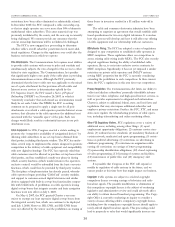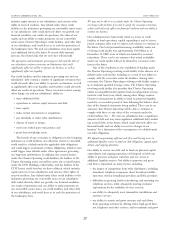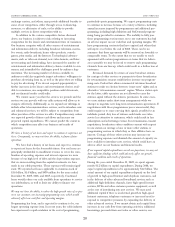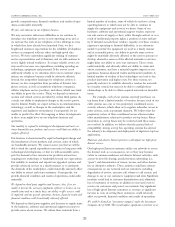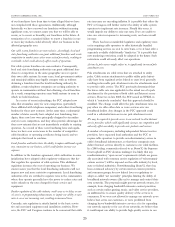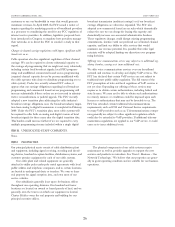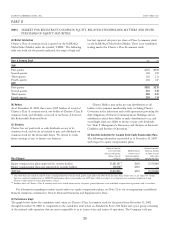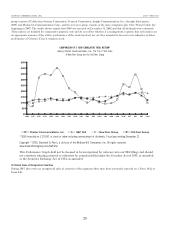Charter 2007 Annual Report Download - page 31
Download and view the complete annual report
Please find page 31 of the 2007 Charter annual report below. You can navigate through the pages in the report by either clicking on the pages listed below, or by using the keyword search tool below to find specific information within the annual report.
exchange carriers, and others, may provide additional benefits to
some of our competitors, either through access to financing,
resources, or efficiencies of scale, or the ability to provide
multiple services in direct competition with us.
In addition to the various competitive factors discussed
above, our business is subject to risks relating to increasing
competition for the leisure and entertainment time of consumers.
Our business competes with all other sources of entertainment
and information delivery, including broadcast television, movies,
live events, radio broadcasts, home video products, console
games, print media, and the Internet. Technological advance-
ments, such as video-on-demand, new video formats, and Inter-
net streaming and downloading, have increased the number of
entertainment and information delivery choices available to con-
sumers, and intensified the challenges posed by audience frag-
mentation. The increasing number of choices available to
audiences could also negatively impact advertisers’ willingness to
purchase advertising from us, as well as the price they are willing
to pay for advertising. If we do not respond appropriately to
further increases in the leisure and entertainment choices avail-
able to consumers, our competitive position could deteriorate,
and our financial results could suffer.
We cannot assure you that the services we provide and the
services we can provide with our cable systems will allow us to
compete effectively. Additionally, as we expand our offerings to
include other telecommunications services, and to introduce new
and enhanced services, we will be subject to competition from
other providers of the services we offer. Competition may reduce
our expected growth of future cash flows and increase our
projected capital expenditures. We cannot predict the extent to
which competition may affect our business and results of
operations.
We have a history of net losses and expect to continue to experience net
losses. Consequently, we may not have the ability to finance future
operations.
We have had a history of net losses and expect to continue
to report net losses for the foreseeable future. Our net losses are
principally attributable to insufficient revenue to cover the com-
bination of operating expenses and interest expenses we incur
because of our high level of debt and the depreciation expenses
that we incur resulting from the capital investments we have
made in our cable properties. These expenses will remain signif-
icant. We reported net losses applicable to common stock of
$1.6 billion, $1.4 billion, and $970 million for the years ended
December 31, 2007, 2006, and 2005, respectively. Continued
losses would reduce our cash available from operations to service
our indebtedness, as well as limit our ability to finance our
operations.
We may not have the ability to reduce the high growth rates of, or pass
on to our customers, our increasing programming costs, which would
adversely affect our cash flow and operating margins.
Programming has been, and is expected to continue to be, our
largest operating expense item. In recent years, the cable industry
has experienced a rapid escalation in the cost of programming,
particularly sports programming. We expect programming costs
to continue to increase because of a variety of factors, including
annual increases imposed by programmers and additional pro-
gramming, including high definition and OnDemand program-
ming, being provided to customers. The inability to fully pass
these programming cost increases on to our customers has had
an adverse impact on our cash flow and operating margins. We
have programming contracts that have expired and others that
will expire at or before the end of 2008. There can be no
assurance that these agreements will be renewed on favorable or
comparable terms. To the extent that we are unable to reach
agreement with certain programmers on terms that we believe
are reasonable we may be forced to remove such programming
channels from our line-up, which could result in a further loss of
customers.
Increased demands by owners of some broadcast stations
for carriage of other services or payments to those broadcasters
for retransmission consent could further increase our program-
ming costs. Federal law allows commercial television broadcast
stations to make an election between “must-carry” rights and an
alternative “retransmission-consent” regime. When a station opts
for the latter, cable operators are not allowed to carry the
station’s signal without the station’s permission. In some cases,
we carry stations under short-term arrangements while we
attempt to negotiate new long-term retransmission agreements. If
negotiations with these programmers prove unsuccessful, they
could require us to cease carrying their signals, possibly for an
indefinite period. Any loss of stations could make our video
service less attractive to customers, which could result in less
subscription and advertising revenue. In retransmission-consent
negotiations, broadcasters often condition consent with respect
to one station on carriage of one or more other stations or
programming services in which they or their affiliates have an
interest. Carriage of these other services may increase our
programming expenses and diminish the amount of capacity we
have available to introduce new services, which could have an
adverse effect on our business and financial results.
If our required capital expenditures exceed our projections, we may not
have sufficient funding, which could adversely affect our growth,
financial condition and results of operations.
During the year ended December 31, 2007, we spent approxi-
mately $1.2 billion on capital expenditures. During 2008, we
expect capital expenditures to be approximately $1.2 billion. The
actual amount of our capital expenditures depends on the level
of growth in high-speed Internet and telephone customers, and
in the delivery of other advanced broadband services such as
additional high-definition channels, faster high-speed Internet
services, DVRs and other customer premise equipment, as well
as the cost of introducing any new services. We may need
additional capital if there is accelerated growth in high-speed
Internet customers, telephone customers or increased need to
respond to competitive pressures by expanding the delivery of
other advanced services. If we cannot obtain such capital from
increases in our cash flow from operating activities, additional
borrowings, proceeds from asset sales or other sources, our
CHARTER COMMUNICATIONS, INC. 2007 FORM 10-K
20






